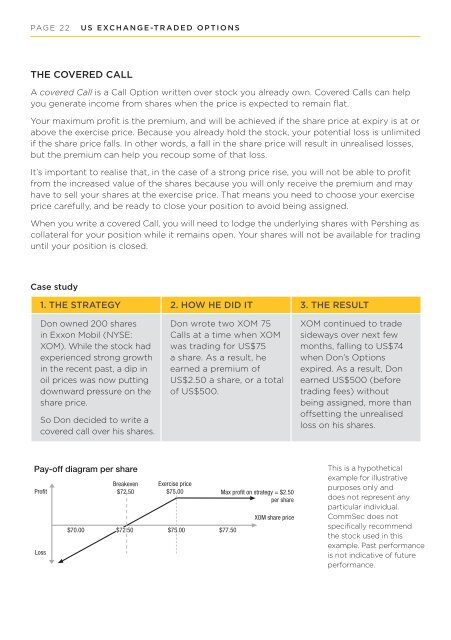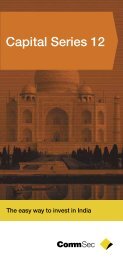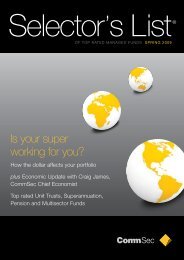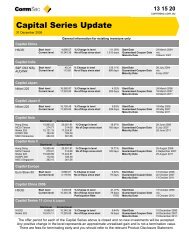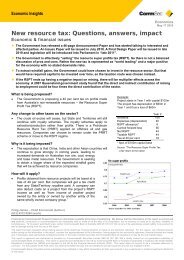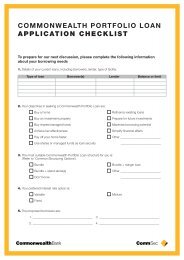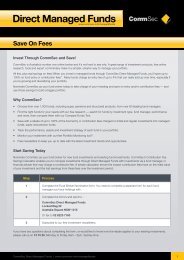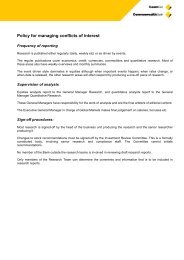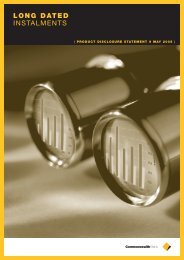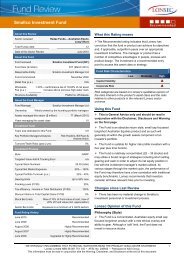US ExchangE- TradEd OpTiOnS prOdUcT diSclOSUrE ... - CommSec
US ExchangE- TradEd OpTiOnS prOdUcT diSclOSUrE ... - CommSec
US ExchangE- TradEd OpTiOnS prOdUcT diSclOSUrE ... - CommSec
Create successful ePaper yourself
Turn your PDF publications into a flip-book with our unique Google optimized e-Paper software.
pag e 2 2<br />
U S E xc h a n g e -t r a d e d o p t i o n s<br />
The covered Call<br />
A covered Call is a Call Option written over stock you already own. Covered Calls can help<br />
you generate income from shares when the price is expected to remain flat.<br />
Your maximum profit is the premium, and will be achieved if the share price at expiry is at or<br />
above the exercise price. Because you already hold the stock, your potential loss is unlimited<br />
if the share price falls. In other words, a fall in the share price will result in unrealised losses,<br />
but the premium can help you recoup some of that loss.<br />
It’s important to realise that, in the case of a strong price rise, you will not be able to profit<br />
from the increased value of the shares because you will only receive the premium and may<br />
have to sell your shares at the exercise price. That means you need to choose your exercise<br />
price carefully, and be ready to close your position to avoid being assigned.<br />
When you write a covered Call, you will need to lodge the underlying shares with Pershing as<br />
collateral for your position while it remains open. Your shares will not be available for trading<br />
until your position is closed.<br />
Case study<br />
1. The strategy 2. How he did it 3. The result<br />
Don owned 200 shares<br />
in Exxon Mobil (NYSE:<br />
XOM). While the stock had<br />
experienced strong growth<br />
in the recent past, a dip in<br />
oil prices was now putting<br />
downward pressure on the<br />
share price.<br />
So Don decided to write a<br />
covered call over his shares.<br />
Don wrote two XOM 75<br />
Calls at a time when XOM<br />
was trading for <strong>US</strong>$75<br />
a share. As a result, he<br />
earned a premium of<br />
<strong>US</strong>$2.50 a share, or a total<br />
of <strong>US</strong>$500.<br />
XOM continued to trade<br />
sideways over next few<br />
months, falling to <strong>US</strong>$74<br />
when Don’s Options<br />
expired. As a result, Don<br />
earned <strong>US</strong>$500 (before<br />
trading fees) without<br />
being assigned, more than<br />
offsetting the unrealised<br />
loss on his shares.<br />
Pay-off diagram per share<br />
Profit<br />
Loss<br />
$70.00<br />
Breakeven<br />
$72.50<br />
$72.50<br />
Exercise price<br />
$75.00<br />
$75.00<br />
Max profit on strategy = $2.50<br />
per share<br />
$77.50<br />
XOM share price<br />
This is a hypothetical<br />
example for illustrative<br />
purposes only and<br />
does not represent any<br />
particular individual.<br />
<strong>CommSec</strong> does not<br />
specifically recommend<br />
the stock used in this<br />
example. Past performance<br />
is not indicative of future<br />
performance.


